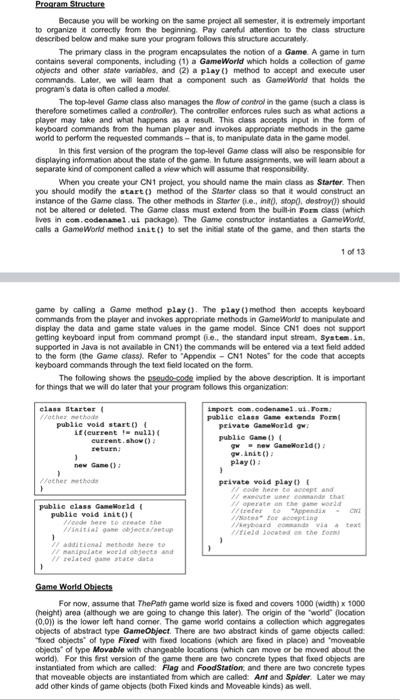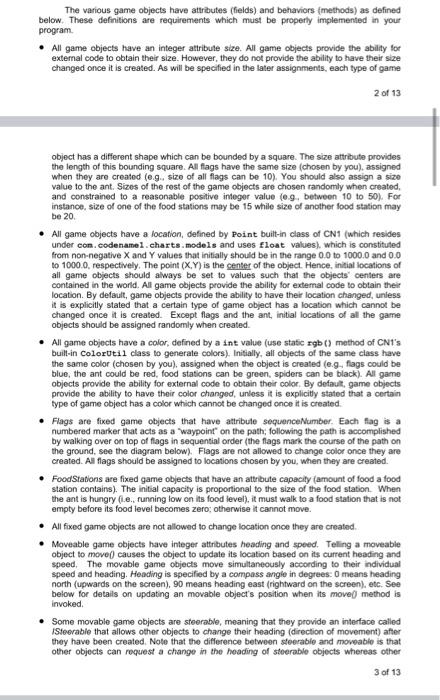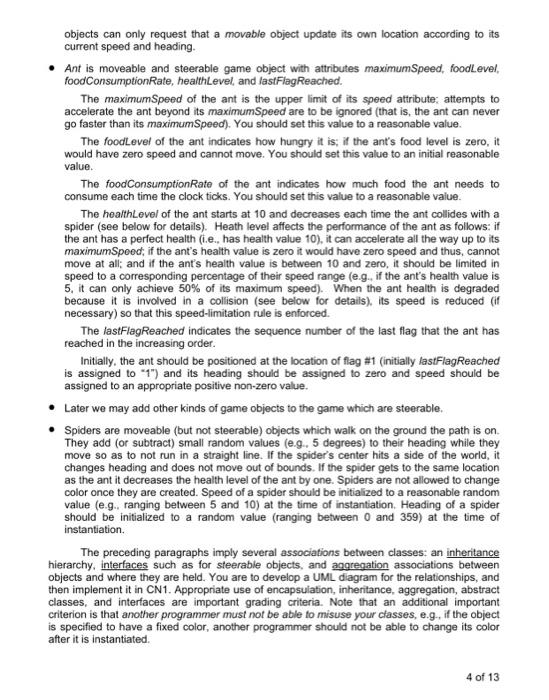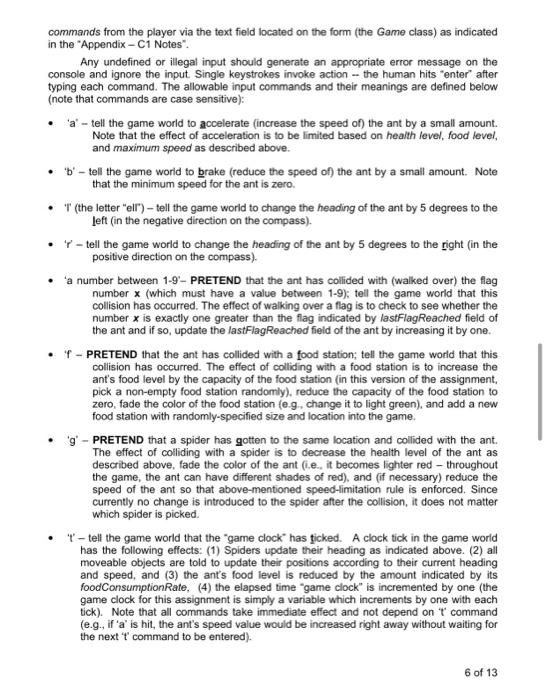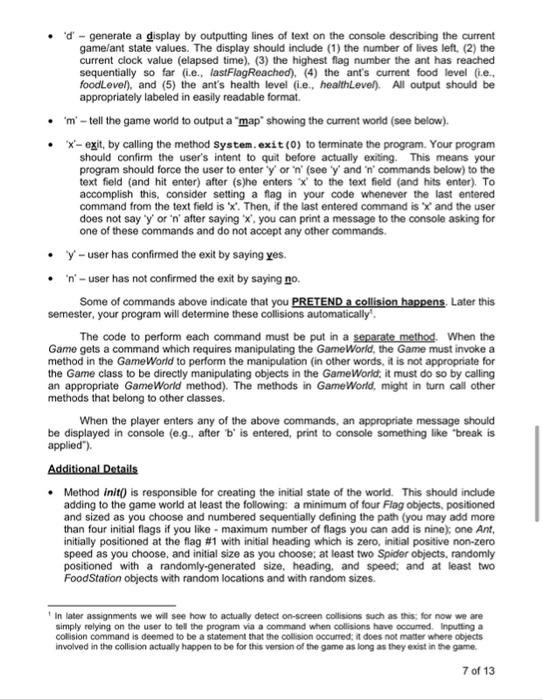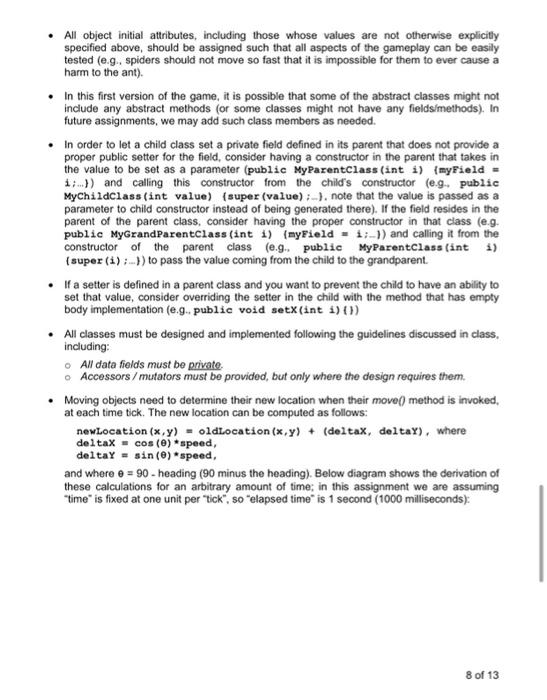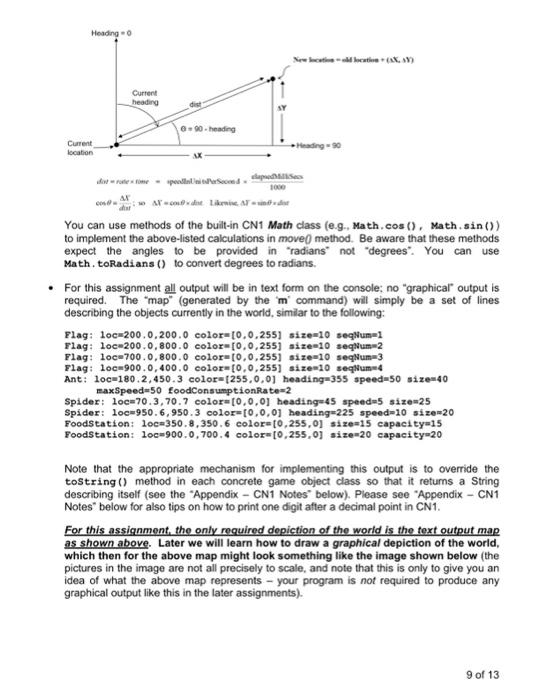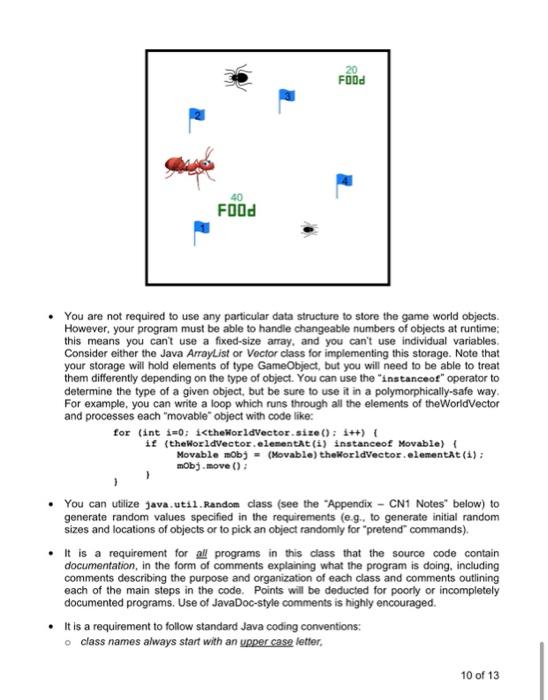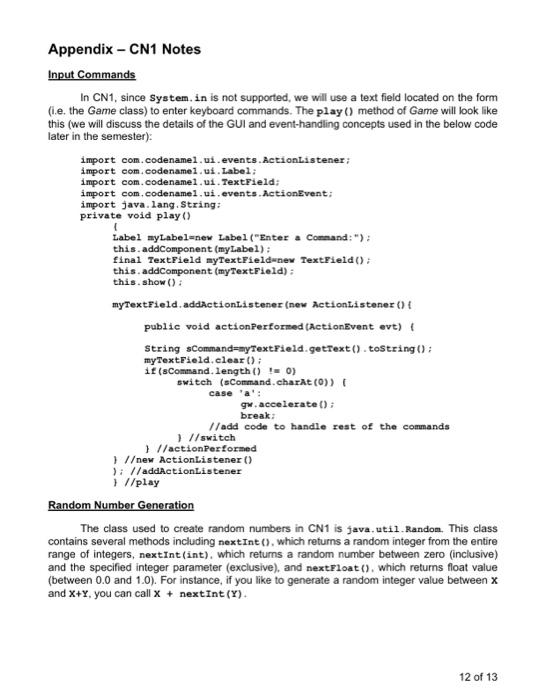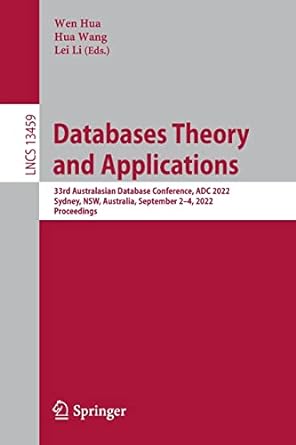Program Structure Because you will be working on the same project all semester, it is extremely important to organize it correctly from the beginning. Pay careful attention to the class structure described below and make sure your program follows this structure accurately The primary class in the program encapsulates the notion of a Game. A game in tum contains several components, including (1) a GameWorld which holds a collection of game objects and other state variables, and (2) a play() method to accept and execute user commands. Later, we will team that a component such as Game World that holds the program's data is often called a model The top-level Game class also manages the flow of control in the game (such a class is therefore sometimes called a controller). The controller enforces rules such as what actions a player may take and what happens as a result. This class accepts input in the form of keyboard commands from the human player and invokes appropriate methods in the game world to perform the requested commands that is, to manipulate data in the game model In this first version of the program the top-level Game class will also be responsible for displaying information about the state of the game. In future assignments, we will learn about a separate kind of component called a view which will assume that responsibility When you create your CN1 project, you should name the main class as Starter. Then you should modify the start() method of the Starter class so that it would construct an instance of the Game class. The other methods in Starterie, init), stop(), destroy() should not be altered or deleted. The Game class must extend from the built-in For class (which lives in con.codenamel.ui package). The Game constructor instantiates a Game World calls a GameWorld method init() to set the initial state of the game, and then starts the 1 of 13 game by caling a Game method play(). The play method then accepts keyboard commands from the player and invokes appropriate methods in Game World to manipulate and display the data and game state values in the game model. Since CN1 does not support getting keyboard input from command prompt po.. the standard input stream. System in supported in Java is not available in CNT) the commands will be entered via a text field added to the form (the Game class). Refer to 'Appendix - CN1 Notes for the code that accepts keyboard commands through the text field located on the form. The following shows the pseudo-code implied by the above description. It is important for things that we will do later that your program follows this organization: class Starter Kather the public void start() 1 (current null) Current show) return; 1 new Game() other the 1 import com.codenamel...Form: public class Game extends Form private GameWorld w publie Game() w new Game World) gw.init() play(); public class Gamelorld publie void init() Med here to create the Winitialan betala aditional method here to manipulate world hectant // related a state data 1 private void play) W code en concept and tener command that operate on the wordt refer to Appendix for opting Hardcovet Wield locate the one Game World Objects For now, assume that ThePath game world size is foved and covers 1000 (width) x 1000 height)area (although we are going to change this later). The origin of the world location (0,01) is the lower left hand comer. The game world contains a collection which aggregates objects of abstract type GameObject. There are two abstract kinds of game objects called: faced objects of type Fixed with fixed locations (which are fixed in place) and moveable objects of type Movable with changeable locations which can move or be moved about the world). For this first version of the game there are two concrete types that fixed objects are instantiated from which are called Flag and Food Station and there are two concrete types that moveable objects are instantiated from which are called Ant and Spider. Later we may add other kinds of game objects (both Fixed kinds and Moveable kinds) as well. The various game objects have attributes (fields) and behaviors (methods) as defined below. These definitions are requirements which must be properly implemented in your program All game objects have an integer attribute size. All game objects provide the ability for external code to obtain their size. However, they do not provide the ability to have their size changed once it is created. As will be specified in the later assignments, each type of game 2 of 13 object has a different shape which can be bounded by a square. The size attribute provides the length of this bounding square. All flags have the same size (chosen by you), assigned when they are created (e.g. size of all flags can be 10). You should also assign a size value to the ant. Sizes of the rest of the game objects are chosen randomly when created, and constrained to a reasonable positive integer value (9 between 10 to 50). For instance, size of one of the food stations may be 15 while size of another food station may be 20 All game objects have a location, defined by Point built-in class of CN1 (which resides under com.codenamel.charts.models and uses float values), which is constituted from non-negative X and Y values that initially should be in the range 0.0 to 1000.0 and 0.0 to 1000.0, respectively. The point(X,Y) is the center of the object. Hence, initial locations of all game objects should always be set to values such that the objects' centers are contained in the world. All game objects provide the ability for external code to obtain their location. By default, game objects provide the ability to have their location changed, unless it is explicitly stated that a certain type of game object has a location which cannot be changed once it is created. Except flags and the ant, initial locations of all the game objects should be assigned randomly when created All game objects have a color, defined by a int value (use static rgb() method of CNt's built-in ColorUtil class to generale colors). Initially, all objects of the same class have the same color (chosen by you), assigned when the object is created (e.g. flags could be blue, the ant could be red, food stations can be green, spiders can be black). All game objects provide the ability for external code to obtain their color By default game objects provide the ability to have their color changed, unless it is explicitly stated that a certain type of game object has a color which cannot be changed once it is created Flags are fixed game objects that have attribute sequence Number. Each flag is a numbered marker that acts as a waypoint on the path, following the path is accomplished by walking over on top of flags in sequential order (the flags mark the course of the path on the ground, see the diagram below). Flags are not allowed to change color once they are created. Al flags should be assigned to locations chosen by you, when they are created. Food Stations are fixed game objects that have an attribute capacity amount of food a food station contains). The initial capacity is proportional to the size of the food station. When the ant is hungry fi.e., running low on its food level), it must walk to a food station that is not empty before its food level becomes zero; otherwise it cannot move. All fixed game objects are not allowed to change location once they are created Moveable game objects have integer attributes heading and speed. Telling a moveable object to move() causes the object to update its location based on its current heading and speed. The movable game objects move simultaneously according to their Individual speed and heading. Heading is specified by a compass angle in degrees. O means heading north (upwards on the screen), 90 means heading east (rightward on the screen), etc. See below for details on updating an movable object's position when its move() method is invoked Some movable game objects are steerable, meaning that they provide an interface called IStorable that allows other objects to change their heading (direction of movement) after they have been created. Note that the difference between sfeerable and moveable is that other objects can request a change in the heading of steerable objects whereas other 3 of 13 objects can only request that a movable object update its own location according to its current speed and heading. Ant is moveable and steerable game object with attributes maximumSpeed, foodLevel, foodConsumption Rate, healthLevel, and lastFlag Reached. The maximumSpeed of the ant is the upper limit of its speed attribute: attempts to accelerate the ant beyond its maximumSpeed are to be ignored (that is, the ant can never go faster than its maximumSpeed). You should set this value to a reasonable value. The foodLevel of the ant indicates how hungry it is if the ant's food level is zero, it would have zero speed and cannot move. You should set this value to an initial reasonable value The foodConsumption Rate of the ant indicates how much food the ant needs to consume each time the clock ticks. You should set this value to a reasonable value. The healthLevel of the ant starts at 10 and decreases each time the ant collides with a spider (see below for details). Heath level affects the performance of the ant as follows: if the ant has a perfect health (i.e., has health value 10), it can accelerate all the way up to its maximumSpeed, if the ant's health value is zero it would have zero speed and thus, cannot move at all: and if the ant's health value is between 10 and zero, it should be limited in speed to a corresponding percentage of their speed range (e.g., if the ant's health value is 5. it can only achieve 50% of its maximum speed). When the ant health is degraded because it is involved in a collision (see below for details). its speed is reduced (if necessary) so that this speed-limitation rule is enforced. The lastFlagReached indicates the sequence number of the last flag that the ant has reached in the increasing order. Initially, the ant should be positioned at the location of flag #1 (initially lastFlagReached is assigned to "1") and its heading should be assigned to zero and speed should be assigned to an appropriate positive non-zero value. Later we may add other kinds of game objects to the game which are steerable. Spiders are moveable (but not steerable) objects which walk on the ground the path is on They add (or subtract) small random values (e-g.. 5 degrees) to their heading while they move so as to not run in a straight line. If the spider's center hits a side of the world, it changes heading and does not move out of bounds. If the spider gets to the same location as the ant it decreases the health level of the ant by one. Spiders are not allowed to change color once they are created. Speed of a spider should be initialized to a reasonable random value (eg, ranging between 5 and 10) at the time of instantiation. Heading of a spider should be initialized to a random value (ranging between 0 and 359) at the time of instantiation The preceding paragraphs imply several associations between classes: an inheritance hierarchy, interfaces such as for steerable objects, and aggregation associations between objects and where they are held. You are to develop a UML diagram for the relationships, and then implement it in CN1. Appropriate use of encapsulation, inheritance, aggregation, abstract classes, and interfaces are important grading criteria. Note that an additional important criterion is that another programmer must not be able to misuse your classes, e.g., if the object is specified to have a fixed color, another programmer should not be able to change its color after it is instantiated 4 of 13 You must use a tool to draw your UML (e.g. Violet or any other UML drawing tool) and Output your UML as a pdf file. Make sure to print your UML to a single-page pdf file in the portrait orientation (it is OK if the fonts and shapes look small on the pdf page since we can zoom-in to see the details). You are not allowed to use tools that automatically generate a UML from your code. Your UML must show all important associations between your entities (and built-in classes/interfaces that your entities extend implement) and utilize correct graphical notations. For your entities you must use three-box notation (for built-in entities use one-box notation) and show all the important fields and methods. You must indicate the visibility modifiers of your fields and methods, but you are not required to show parameters in methods and return types of the methods. Game Play When the game starts the player has three "ives" (chances to reach the last flag). The game has a clock which counts up starting from zero and the objective is to walk around the path to the last flag in the minimum amount of time. The player uses keystroke commands to change the ant's heading (see below for details). The ant moves by its current speed in the direction it is currently heading each time the game clock "ticks" (see below). The ant starts out at the first flag (#1). The player must walk the ant so that it intersects the flags in increasing numerical order. Each time the ant reaches the next higher-numbered flag the ant is deemed to have successfully walk that far along the path and its fastFlagReached field is updated. Intersecting flags out of order that is reaching a flag whose number is more than one greater than the most recently reached flag, or whose number is less than or equal to the most recently reached flag) has no effect on the game. The food level of the ant continually goes down as the game continues. If the ant's food level reaches zero it can no longer move. The player must therefore occasionally walk the ant off the path to intersect with a food station, which has the effect of increasing the ant's food level by the capacity of the food station. After the ant intersects with the food station, the capacity of that food station is reduced to zero and a new food station with randomly-specified size and location is added into the game. Collisions with spiders decrease the health level of the ant by one if the health level of the ant reaches zero, it can no longer move. If the ant can no longer move (i.e., its food or health level has reached zero), the game stops (the player "loses a life") and the game world is re-initialized (but the number of clock ticks is not set back to zero). When the player loses all three lives the game ends and the program exits by printing the following text message in console: "Game over, you failed!". If the ant reaches the last flag on the path, the game also ends with the following message displayed on the console: "Game over, you win! Total time:#, where # indicates the number of clock ticks it took the ant to reach the last flag on the path. The program keeps track of following game state" values: current clock time and lives remaining Note that these values are part of the model and therefore belong in the Game World class Commands Once the game world has been created and initialized, the Game constructor is to call a method name play() to actually begin the game play accepts single-character 5 of 13 commands from the player via the text field located on the form (the Game class) as indicated in the "Appendix - ci Notes". Any undefined or illegal input should generate an appropriate error message on the console and ignore the input Single keystrokes invoke action -- the human hits 'enter' after typing each command. The allowable input commands and their meanings are defined below (note that commands are case sensitive): a - tell the game world to accelerate (increase the speed of the ant by a small amount. Note that the effect of acceleration is to be limited based on health level, food level, and maximum speed as described above. 'b' - tell the game world to brake (reduce the speed of) the ant by a small amount. Note that the minimum speed for the ant is zero (the letter "ell") - tell the game world to change the heading of the ant by 5 degrees to the left (in the negative direction on the compass). .Y- tell the game world to change the heading of the ant by 5 degrees to the right in the positive direction on the compass). a number between 1-9 - PRETEND that the ant has collided with (walked over the flag number (which must have a value between 1-9): tell the game world that this collision has occurred. The effect of walking over a flag is to check to see whether the number x is exactly one greater than the flag indicated by lastFlagReached field of the ant and if so, update the lastFlagReached field of the ant by increasing it by one. - PRETEND that the ant has collided with a food station; tell the game world that this collision has occurred. The effect of colliding with a food station is to increase the ant's food level by the capacity of the food station in this version of the assignment pick a non-empty food station randomly), reduce the capacity of the food station to zero, fade the color of the food station (e.g. change it to light green), and add a new food station with randomly-specified size and location into the game. PRETEND that a spider has gotten to the same location and collided with the ant. The effect of colliding with a spider is to decrease the health level of the ant as described above, fade the color of the ant (.e., it becomes lighter red - throughout the game, the ant can have different shades of red), and if necessary) reduce the speed of the ant so that above-mentioned speed-limitation rule is enforced. Since currently no change is introduced to the spider after the collision, it does not matter which spider is picked. t-telf the game world that the game clock has ticked. A clock tick in the game world has the following effects: (1) Spiders update their heading as indicated above. (2) all moveable objects are told to update their positions according to their current heading and speed, and (3) the ant's food level is reduced by the amount indicated by its foodConsumptionRate, (4) the elapsed time "game clock is incremented by one (the game clock for this assignment is simply a variable which increments by one with each tick). Note that all commands take immediate effect and not depend on 1 command (e.g., if'a' is hit the ant's speed value would be increased right away without waiting for the next t' command to be entered). 6 of 13 . 'd' - generate a display by outputting lines of text on the console describing the current game/ant state values. The display should include (1) the number of lives left. (2) the current clock value (elapsed time). (3) the highest flag number the ant has reached sequentially so far (i.e., lastFlag Reached). (4) the ant's current food level (ie.. foodLevel), and (5) the ant's health level (i.e., healthLevel). All output should be appropriately labeled in easily readable format. m - tell the game world to output a "map" showing the current world (see below). x-exit, by calling the method System.exit(0) to terminate the program. Your program should confirm the user's intent to quit before actually exiting. This means your program should force the user to enter y or 'n' (see y and in commands below) to the text field (and hit enter) after (s)he enters x to the text field (and hits enter). To accomplish this, consider setting a fiag in your code whenever the last entered command from the text field is 'x. Then, if the last entered command is X and the user does not say y or 'n' after saying x, you can print a message to the console asking for one of these commands and do not accept any other commands y - user has confirmed the exit by saying yes. in- user has not confirmed the exit by saying no. Some of commands above indicate that you PRETEND a collision happens. Later this semester, your program will determine these collisions automatically The code to perform each command must be put in a separate method. When the Game gets a command which requires manipulating the Game World, the Game must invoke a method in the Game World to perform the manipulation (in other words, it is not appropriate for the Game class to be directly manipulating objects in the Game World, it must do so by calling an appropriate Game World method). The methods in Game World, might in turn call other methods that belong to other classes When the player enters any of the above commands, an appropriate message should be displayed in console (e.g. after b' is entered, print to console something like "break is applied"). Additional Details Method init() is responsible for creating the initial state of the world. This should include adding to the game world at least the following: a minimum of four Flag objects, positioned and sized as you choose and numbered sequentially defining the path (you may add more than four initial flags if you like - maximum number of flags you can add is nine) one Ant initially positioned at the flag #1 with initial heading which is zero, initial positive non-zero speed as you choose, and initial size as you choose, at least two Spider objects, randomly positioned with a randomly-generated size, heading, and speedand at least two Food Station objects with random locations and with random sizes. In later assignments we will see how to actually detect on-screen collisions such as this for now we are simply relying on the user to tell the program via a command when collisions have occurred inputting a collision command is deemed to be a statement that the collision occurred it does not matter where objects involved in the collision actually happen to be for this version of the game as long as they exist in the game. 7 of 13 All object initial attributes, including those whose values are not otherwise explicitly specified above, should be assigned such that all aspects of the gameplay can be easily tested (e.g. spiders should not move so fast that it is impossible for them to ever cause a harm to the ant). In this first version of the game, it is possible that some of the abstract classes might not include any abstract methods (or some classes might not have any fields/methods). In future assignments, we may add such class members as needed. In order to let a child class set a private field defined in its parent that does not provide a proper public setter for the field, consider having a constructor in the parent that takes in the value to be set as a parameter (public MyParentClass(int i) {myField = 1,...)) and calling this constructor from the child's constructor (e.g., public MyChildClass(int value) (super (value):-), note that the value is passed as a parameter to child constructor instead of being generated there). If the field resides in the parent of the parent class, consider having the proper constructor in that class (e.g. public MyGrandparentClass(int i) (myField - 1:-)) and calling it from the constructor of the parent class (e.g. public MyParentClass(int i) (super (i):...) to pass the value coming from the child to the grandparent. If a setter is defined in a parent class and you want to prevent the child to have an ability to set that value, consider overriding the setter in the child with the method that has empty body implementation (e.g. public void setx (int i) ()) All classes must be designed and implemented following the guidelines discussed in class. including: All data fields must be private Accessors/mutators must be provided, but only where the design requires them. Moving objects need to determine their new location when their move() method is invoked. at each time tick. The new location can be computed as follows: newLocation (x,y) = oldLocation(x,y) + (deltax, deltay), where deltax - cos (0) speed, deltay = sin()*speed, and where e = 90 - heading (90 minus the heading). Below diagram shows the derivation of these calculations for an arbitrary amount of time; in this assignment we are assuming "time" is fixed at one unit per tick", so "elapsed time" is 1 second (1000 milliseconds): 8 of 13 monding Heading Current heading dis 6.90 .heading Current location ding - 90 X Miss 1000 D AY - You can use methods of the built-in CN1 Math class (e.g., Math.cos(), Math.sin()) to implement the above-listed calculations in move() method. Be aware that these methods expect the angles to be provided in radians not degrees You can use Math.toRadians() to convert degrees to radians. . For this assignment all output will be in text form on the console: no "graphical output is required. The "map" (generated by the mi command) will simply be a set of lines describing the objects currently in the world, similar to the following: Flag: loc=200.0,200.0 color=[0.0.255) size=10 seqNum=1 Flag: loc200.0,800.0 color [0,0,255) size 10 seqNum2 Flag: loc=700.0,800.0 color=[0,0,255] size=10 seqNum=3 Flag: loc-900.0,400.0 color=[0,0,255) size 10 seqNume Ant: loc=180.2.450.3 color=[255,0.01 heading=355 speed=50 size 40 maxSpeed 50 foodConsumption Rate=2 Spider: loca70.3, 70.7 colorat0,0,0] heading-45 speed 5 size 25 Spider: loc-950.6.950.3 color=[0,0,01 heading=225 speed=10 size=20 Foodstation: loca350.8,350.6 colorato,255,0) size 15 capacity=15 FoodStation: loc=900.0.700.4 color=[0,255,0) size=20 capacity=20 Note that the appropriate mechanism for implementing this output is to override the toString() method in each concrete game object class so that it returns a String describing itself (see the "Appendix - CN1 Notes below). Please see "Appendix - CN1 Notes" below for also tips on how to print one digit after a decimal point in CN1. For this assignment, the only required depiction of the world is the text output map as shown above. Later we will learn how to draw a graphical depiction of the world, which then for the above map might look something like the image shown below (the pictures in the image are not all precisely to scale, and note that this is only to give you an idea of what the above map represents - your program is not required to produce any graphical output like this in the later assignments). 9 of 13 20 FOOD FOOD You are not required to use any particular data structure to store the game world objects. However, your program must be able to handle changeable numbers of objects at runtime: this means you can't use a fixed-size array, and you can't use individual variables Consider either the Java ArrayList or Vector class for implementing this storage. Note that your storage will hold elements of type GameObject, but you will need to be able to treat them differently depending on the type of object. You can use the instanceof" operator to determine the type of a given object, but be sure to use it in a polymorphically-safe way. For example, you can write a loop which runs through all the elements of the WorldVector and processes each "movable object with code like: for (int i=0; i
